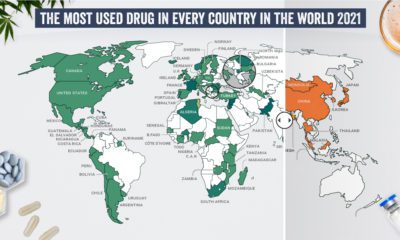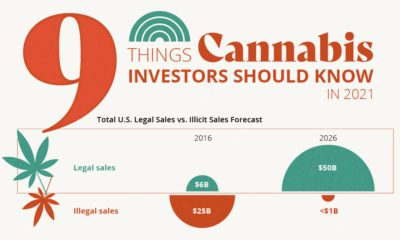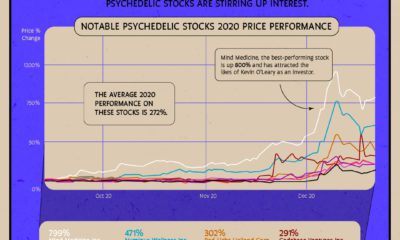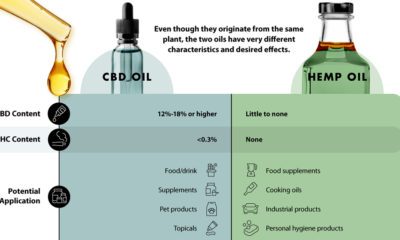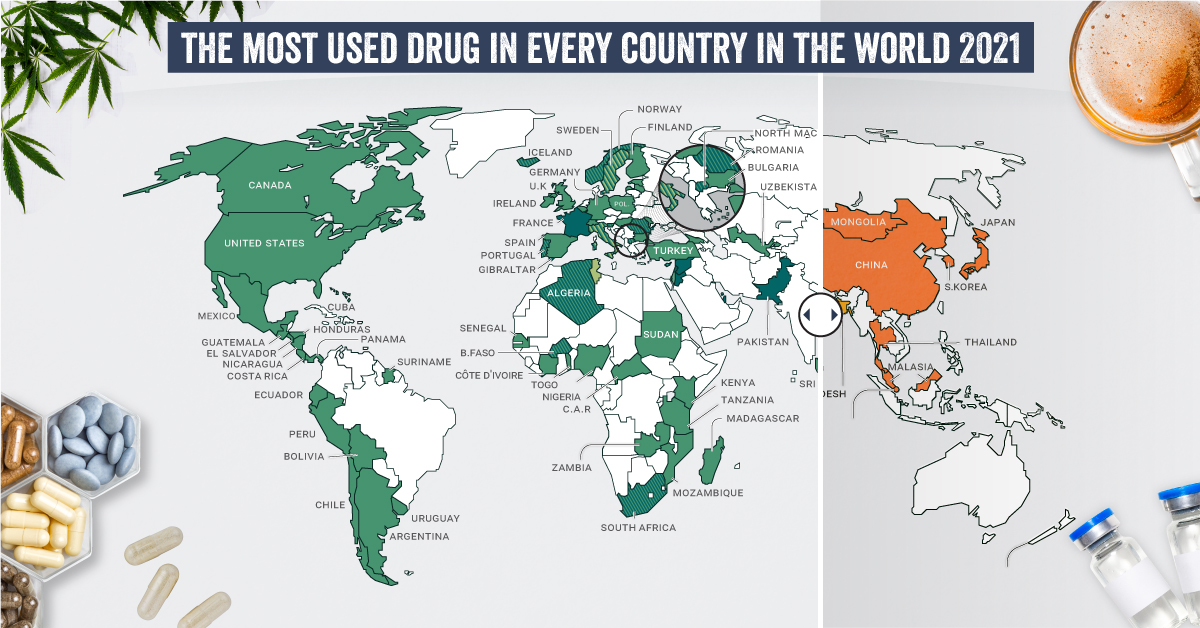With the birth of legal recreational markets in places like California and a growing appreciation for the medical applications of cannabinoids such as CBD, the floodgates are open for companies to pursue new and groundbreaking opportunities in the sector. Unlike other fields where medical research has been mainstream for many decades, the work behind cannabis – an incredibly complex plant – is only getting started.
Untapped Potential
Today’s infographic comes from InMed Pharmaceuticals and it explains the medical potential behind the 90+ cannabinoids that we have yet to fully understand. It also details a scientific process known as biosynthesis, which helped revolutionize the production of insulin for diabetics. A process such as this may be a key in unlocking the medical potential of understudied cannabinoids.
The medical benefits of cannabis are many, and scientific research is being conducted to explore the application of the plant in several disease categories, including multiple sclerosis, seizures, glaucoma, cancer, Alzheimer’s, and migraines. However, this is just the tip of the iceberg. To understand the full potential of the cannabis plant, you need to know what cannabinoids are, and how they work.
The Human Endocannabinoid System
Like all mammals, the human body is loaded with natural cannabinoid receptors. These receptors interact with cannabinoids, which occur naturally in the human body, but also in the cannabis plant. Some cannabinoids you may know include THC and CBD – and they have a wide variety of applications. They also make up the majority of cannabinoids (by volume) that can be easily extracted from the plant. However, there are actually 90+ other cannabinoids that have potential medical benefits as well, and they make up less than 0.1% of total biomass. Because they are so difficult to isolate, they remain understudied in medicinal science.
A Problem of Volume
With only a tiny portion of the cannabis plant having medicinal value (the cannabinoids), a large degree of biomass must be harvested to extract even small amounts of medicine. For example, 3 lbs (1.36 kg) of hig-CBD flowers may only yield 50 grams of pharmaceutical-grade compounds. But this ratio is even more strenuous for the 90+ rare cannabinoids that make up less than 0.1% of the plant. With costs in the millions of dollars-per-gram range, it is extremely cost prohibitive to be researching these cannabinoids in any in-depth capacity.
Biosynthesis for Cannabinoids?
The process of biosynthesis could be a clue to maximizing the potential of these understudied cannabinoids. In fact, this innovation has already helped democratize access to insulin, which originally was an extremely rare and expensive compound. To get just eight ounces of insulin, over 5,000 pig pancreases had to be harvested and processed. With biosynthesis, that is no longer the case. Biosynthesis is a process that can occur by genetically modifying an organism to produce a pharmaceutically bioactive compounds that it normally would not make. Biosynthesis could thus be used to produce rare cannabinoids that are biologically identical to those produced by the cannabis plant itself. Here’s how it works:
- A biosynthetic cluster is inserted into a DNA vector. 2) DNA is inserted into E. Coli bacteria, where it provides instructions to produce cannabinoid compound(s) 3) The process is conducted at a large scale, resulting in materials that can be further processed into purified cannabinoids
The Potential of Biosynthesis
The world’s largest cannabis biotech company, GW Pharmaceuticals, has signed a contract with British Sugar to grow 18 hectares of cannabis for its CBD epilepsy drug, Epidiolex™. Equivalent to approximately 23 football fields of greenhouse space, this represents a considerable amount of resources and investment needed to grow enough crops to treat 40,000 children with the disease. If biosynthesis can produce similar quantities of cannabinoids from a much smaller space, it would be disruptive to the industry. Further, it may also make getting other understudied cannabinoids more economic – helping to possibly unleash the full medicinal potential of the cannabis plant.
on Humans have a storied and complicated relationship with drugs. Defined as chemical substances that cause a change in our physiology or psychology, many drugs are taken medicinally or accepted culturally, like caffeine, nicotine, and alcohol. But many drugs—including medicines and non-medicinal substances taken as drugs—are taken recreationally and can be abused. Each country and people have their own relationship to drugs, with some embracing the use of specific substances while others shun them outright. What are the most common drugs that are considered generally illicit in different parts of the world? Today’s graphics use data from the UN’s World Drug Report 2021 to highlight the most prevalent drug used in each country.
What Types of Common Drugs Are Tracked?
The World Drug Report looks explicitly at the supply and demand of the international illegal drug market, not including commonly legal substances like caffeine and alcohol. Drugs are grouped by class and type, with six main types of drugs found as the most prevalent drugs worldwide.
Cannabis*: Drugs derived from cannabis, including hemp. This category includes marijuana (dried flowers), hashish (resin), and other for various other parts of the plant or derived oils. Cocaine: Drugs derived from the leaves of coca plants. Labeled as either cocaine salts for powder form or crack for cocaine processed with baking soda and water into rock form. Opioids: Includes opiates which are derived directly from the opium poppy plant, including morphine, codeine, and heroin, as well as synthetic alkaloids. Amphetamine-type Stimulants (ATS): Amphetamine and drugs derived from amphetamine, including meth (also known as speed), MDMA, and ecstasy. Sedatives and Tranquilizers: Includes other drugs whose main purpose is to reduce energy, excitement, or anxiety, as well as drugs used primarily to initiate or help with sleep (also called hypnotics). Solvents and Inhalants: Gases or chemicals that can cause intoxication but are not intended to be drugs, including fuels, glues, and other industrial substances.
The report also tracked the prevalence of hallucinogens—psychoactive drugs which strongly affect the mind and cause a “trip”—but no hallucinogens ranked as the most prevalent drug in any one country. *Editor’s note: Recreational cannabis is legal in five countries, and some non-federal jurisdictions (i.e. states). However, in the context of this report, it was included because it is still widely illicit in most countries globally.
The Most Prevalent Drug in Each Country
According to the report, 275 million people used drugs worldwide in 2020. Between the ages of 15–64, around 5.5% of the global population used drugs at least once. Many countries grouped different types of the same drug class together, and a few like Saudi Arabia and North Macedonia had multiple different drug types listed as the most prevalent. But across the board, cannabis was the most commonly prevalent drug used in 107 listed countries and territories: How prevalent is cannabis worldwide? 72 locations or more than two-thirds of those reporting listed cannabis as the most prevalent drug. Unsurprisingly these include countries that have legalized recreational cannabis: Canada, Georgia, Mexico, South Africa, and Uruguay.
How Common Are Opioids and Other Drugs?
Though the global prevalence of cannabis is unsurprising, especially as it becomes legalized and accepted in more countries, other drugs also have strong footholds. Opioids (14 locations) were the most prevalent drugs in the Middle-East, South and Central Asia, including in India and Iran. Notably, Afghanistan is the world’s largest producer of opium, supplying more than 90% of illicit heroin globally. Amphetamine-type drugs (9 locations) were the third-most common drugs overall, mainly in East Asia. Methamphetamine was the reported most prevalent drug in China, South Korea, and Japan, while amphetamine was only the most common drug in Bangladesh. However, it’s important to note that illicit drug usage is tough to track. Asian countries where cannabis is less frequently found (or reported) might understate its usage. At the same time, the opioid epidemic in the U.S. and Canada reflects high opioid usage in the West. As some drugs become more widespread and others face a renewed “war,” the landscape is certain to shift over the next few years.



